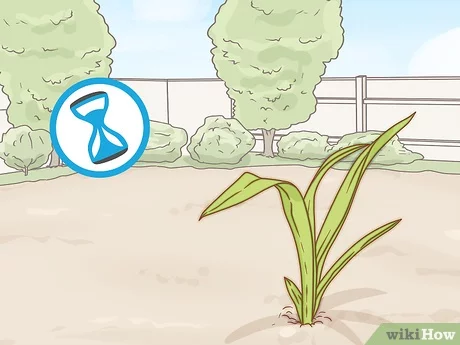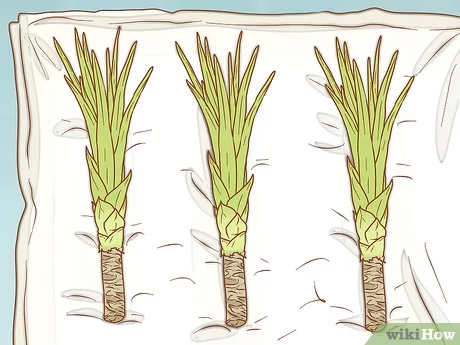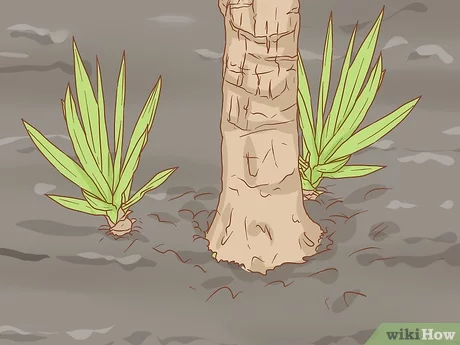- Why Transplant Yucca Filamentosa?
- Benefits of Transplanting Yucca Filamentosa
- Choosing the Right Time to Transplant
- Preparing Your Garden for Yucca Filamentosa
- 1. Choose the Right Location
- 2. Clear the Area
- 3. Add Organic Matter
- 4. Amend the Soil
- 5. Create a Planting Hole
- 6. Water the Soil
- 7. Plant the Yucca
- 8. Water the Plant
- Step-by-Step Guide to Transplanting Yucca Filamentosa
- 1. Choose the Right Time
- 2. Prepare the New Planting Location
- 3. Dig the Hole
- 4. Carefully Remove the Plant from its Container
- 5. Place the Plant in the Hole
- 6. Backfill the Hole
- 7. Water the Transplanted Yucca
- 8. Mulch and Monitor
- 9. Provide Care and Maintenance
- Transplanting Yucca Filamentosa: Common Mistakes to Avoid
- 1. Choosing the wrong time to transplant
- 2. Failing to prepare the new planting location
- 3. Not digging a large enough planting hole
- 4. Overwatering after transplanting
- 5. Neglecting to protect the plant
- 6. Failing to acclimate the plant
- 7. Ignoring proper maintenance after transplantation
- Caring for Transplanted Yucca Filamentosa in Autumn
- 1. Watering
- 2. Mulching
- 3. Fertilizing
- 4. Pruning
- 5. Winter Protection
- 6. Monitoring
- 7. Continued Care
- Final Thoughts on Transplanting Yucca Filamentosa
- Questions and Answers:
- Can I transplant yucca filamentosa in autumn?
- How do I prepare the soil before transplanting yucca filamentosa?
- How should I dig up yucca filamentosa for transplantation?
- Where should I place the yucca filamentosa after transplanting?
- How long does it take for yucca filamentosa to establish after transplantation?
- Videos: Dividing Yucca Elephantipes & How To Create A Multiple Stalk Arrangement
Yucca filamentosa, also known as Adam’s needle, is a striking perennial plant that can add a touch of drama to any garden. With its bold, spiky leaves and tall, showy flower stalks, it is a popular choice for many gardeners. If you have a yucca filamentosa that has outgrown its current spot or you simply want to move it to a different area of your garden, autumn is the ideal time to do so. Transplanting yucca filamentosa in the fall allows the plant to establish its roots before the winter frost sets in, ensuring its survival and future growth.
Before you start the transplanting process, there are a few important steps to follow. First, prepare the new location in your garden where you want to transplant the yucca filamentosa. Choose an area that receives full sun and has well-draining soil. Yucca filamentosa thrives in sandy or loamy soil, so make sure the new spot meets these requirements. If necessary, amend the soil with organic matter to improve drainage and fertility.
Next, dig a hole in the new location that is twice as wide and deep as the yucca filamentosa’s root ball. This will give the plant enough space to spread its roots and establish itself in its new home. Take care to remove any weeds or rocks from the hole to ensure a clean planting area. Once the hole is prepared, water it thoroughly to help settle the soil.
Now it’s time to carefully dig up the yucca filamentosa from its current spot. Start by pruning back any dead or damaged leaves, as well as any flower stalks that are present. This will make the transplanting process easier and reduce stress on the plant. Using a sharp spade or garden fork, dig around the plant to loosen the soil and gently lift the yucca filamentosa out of the ground, taking care not to damage the roots.
Why Transplant Yucca Filamentosa?

Transplanting Yucca Filamentosa, commonly known as Adam’s Needle, is a great choice for gardeners looking to add a unique and low-maintenance plant to their garden. Here are a few reasons why you should consider transplanting Yucca Filamentosa:
- Drought Tolerance: Yucca Filamentosa is a desert plant and thrives in dry conditions. It has adapted to survive in arid environments, making it an excellent choice for gardens with limited water resources.
- Attractive Appearance: Yucca Filamentosa features striking sword-like leaves with sharp tips and creamy white flowers that bloom in late spring. Its architectural beauty adds a dramatic element to any garden.
- Low Maintenance: Once established, Yucca Filamentosa requires minimal maintenance. It is highly resistant to pests, diseases, and deer, making it a hassle-free addition to your garden.
- Year-Round Interest: Yucca Filamentosa remains visually appealing throughout the year. Its evergreen foliage provides interest even in colder months, making it an ideal choice for gardens that need some winter color.
- Adaptable to Various Soil Types: Yucca Filamentosa can tolerate a wide range of soil types, including sandy, loamy, and clay soils. It can handle both acidic and alkaline environments, making it a versatile plant for various garden settings.
If you are looking for a hardy and visually striking plant that requires minimal care, transplanting Yucca Filamentosa is an excellent choice. With its striking foliage, beautiful flowers, and resilience to harsh conditions, it is sure to be a standout addition to your garden.
Benefits of Transplanting Yucca Filamentosa
- Improved Growth: Transplanting yucca filamentosa to your garden in autumn can help improve its growth. By providing the plant with a new and larger space, it allows the yucca to spread its roots and establish itself more efficiently.
- Enhanced Health: Transplanting also helps rejuvenate the yucca plant, as it removes old and tired roots and replaces them with fresh ones. This results in a healthier and stronger plant that is more resistant to diseases and pests.
- Increased Flowering: Yucca filamentosa is known for its attractive blooms, and transplanting can actually stimulate flowering. By transplanting the yucca in the autumn, you are giving it the ideal conditions to bloom vigorously in the following spring and summer.
- Aesthetic Appeal: Yucca filamentosa is a visually appealing plant that adds a touch of exotic beauty to any garden. By transplanting it, you can strategically place the yucca in an area that enhances your overall garden design and creates a focal point or accent feature.
- Drought Tolerance: Yucca filamentosa is a hardy plant that thrives in dry conditions. By transplanting it to a suitable location, you are allowing the yucca to adapt and become more tolerant to periods of drought. This can be particularly beneficial in regions with low rainfall or during dry summers.
Overall, transplanting yucca filamentosa to your garden in autumn offers multiple advantages. It helps to promote growth, improve the plant’s health, increase flowering, enhance your garden’s aesthetic appeal, and boost its drought tolerance. By following the step-by-step guide, you can successfully transplant yucca filamentosa and enjoy all of these benefits in your garden.
Choosing the Right Time to Transplant
Transplanting yucca filamentosa can be a delicate process, and choosing the right time to do it is crucial for the plant’s success in its new location. Autumn is generally considered the best time to transplant yucca filamentosa for several reasons:
- Favorable Weather Conditions: Autumn provides more favorable weather conditions for transplanting yucca filamentosa. The cooler temperatures and reduced heat stress on the plant make it easier for the roots to establish themselves in the new location.
- Dormancy Period: In autumn, the yucca filamentosa plant enters its dormancy period, which means it is less active and growing more slowly. Transplanting during this time minimizes the shock to the plant and allows it to focus on root development.
- Preparation for Winter: By transplanting yucca filamentosa in autumn, you give the plant enough time to acclimate to its new location and establish a strong root system before winter arrives. This prepares the plant for the challenges of the cold season.
It is important to note that the exact timing for transplanting yucca filamentosa may vary depending on your specific region and climate conditions. It is recommended to consult with local gardening experts or refer to gardening resources specific to your area for the most accurate guidance on the ideal transplanting time.
Preparing Your Garden for Yucca Filamentosa
Before transplanting yucca filamentosa to your garden, it’s important to make sure your garden is ready to accommodate this unique plant. Here are some steps you can follow to prepare your garden:
1. Choose the Right Location

Yucca filamentosa requires a sunny location with well-draining soil. Look for a spot in your garden that receives at least 6-8 hours of direct sunlight each day and has soil that doesn’t retain too much water. Yucca plants don’t tolerate wet or waterlogged soil, so make sure to choose a spot with good drainage.
2. Clear the Area

Clear the area in your garden where you plan to transplant the yucca filamentosa. Remove any weeds, grass, or other plants that might compete with the yucca for nutrients and space. Use a shovel or garden fork to loosen the soil and remove any large rocks or debris.
3. Add Organic Matter
Yucca filamentosa thrives in soil that is rich in organic matter. Add a layer of well-rotted compost or aged manure to the planting area and mix it into the soil. This will improve the soil’s fertility and provide essential nutrients for the yucca.
4. Amend the Soil
If your soil is heavy and clayey, consider adding sand or perlite to improve its drainage. Yucca plants prefer soil that is loose and well-draining. Mix the amendments thoroughly with the existing soil to create a well-balanced growing medium for the yucca.
5. Create a Planting Hole
Dig a planting hole that is slightly larger and deeper than the rootball of the yucca filamentosa. The hole should be wide enough to accommodate the entire plant without cramping its roots. Ensure that the hole is at the same level as the yucca’s current soil line.
6. Water the Soil
Before planting the yucca filamentosa, thoroughly water the soil in the planting hole. This will help settle the soil and ensure good contact between the roots and the surrounding soil.
7. Plant the Yucca
Place the yucca filamentosa in the planting hole, making sure that the rootball is positioned at the same level as the surrounding soil. Backfill the hole with the amended soil, gently firming it around the roots to eliminate any air pockets.
8. Water the Plant
After planting, thoroughly water the yucca filamentosa to help it establish. Provide enough water to moisten the entire root zone, but avoid overwatering, as yucca plants prefer drier conditions. After the initial watering, water the yucca only when the top inch of soil feels dry to the touch.
By following these steps, you can ensure that your garden is well-prepared to receive the yucca filamentosa. With proper care and maintenance, this beautiful plant will thrive and enhance the aesthetic appeal of your garden.
Step-by-Step Guide to Transplanting Yucca Filamentosa
Transplanting yucca filamentosa, also known as Adam’s needle, can be a rewarding and relatively simple process. Here is a step-by-step guide to help you successfully transplant this beautiful plant in your garden:
1. Choose the Right Time
It is best to transplant yucca filamentosa in the autumn when the temperatures are cooler and the plant is in its dormant phase. This will give the plant a chance to settle into its new location before the next growing season.
2. Prepare the New Planting Location
Before transplanting, prepare the new planting location by clearing away any weeds or debris. Yucca filamentosa prefers well-draining soil, so add compost or sand if needed to improve drainage.
3. Dig the Hole
Dig a hole that is twice the width and depth of the yucca filamentosa’s root ball. This will provide enough space for the roots to spread out and establish themselves in the new location.
4. Carefully Remove the Plant from its Container
If the yucca filamentosa is currently in a container, gently tap the sides and bottom of the container to loosen the root ball. Carefully remove the plant, taking care not to damage the roots.
5. Place the Plant in the Hole
Place the yucca filamentosa in the hole, ensuring that the top of the root ball is level with or slightly above the surrounding soil. This will help prevent water from pooling around the plant’s crown, which can lead to rot.
6. Backfill the Hole
Backfill the hole with soil, gently firming it around the plant’s roots. Avoid compacting the soil too much, as this can hinder root growth.
7. Water the Transplanted Yucca
Give the transplanted yucca filamentosa a thorough watering immediately after planting. This will help settle the soil around the roots and encourage new growth.
8. Mulch and Monitor
Apply a layer of mulch around the base of the plant to help retain moisture and suppress weed growth. Monitor the soil moisture level regularly and water as needed, ensuring that the plant receives adequate hydration throughout the year.
9. Provide Care and Maintenance
Yucca filamentosa is a relatively low-maintenance plant. Remove any dead or damaged leaves as needed and fertilize lightly in the spring with a balanced fertilizer. Prune any spent flower stalks to promote the growth of new ones.
By following these steps, you can successfully transplant yucca filamentosa and enjoy its striking foliage and beautiful flowers in your garden!
Transplanting Yucca Filamentosa: Common Mistakes to Avoid
Transplanting yucca filamentosa, also known as Adam’s needle, can be a rewarding addition to your garden. However, it is important to avoid common mistakes to ensure the successful transplantation of this hardy plant. Here are some common mistakes to avoid:
1. Choosing the wrong time to transplant

Transplanting yucca filamentosa should be done in autumn when the plant is entering a dormant period. This allows the plant to establish its roots before the onset of winter. Avoid transplanting during the spring or summer when the plant is actively growing, as this can cause stress and decrease survival rates.
2. Failing to prepare the new planting location
Before transplanting, prepare the new planting location by loosening the soil and incorporating organic matter to improve drainage. Yucca filamentosa prefers well-drained soil, so this step is crucial for its successful establishment.
3. Not digging a large enough planting hole
Yucca filamentosa has a deep taproot, so it is important to dig a planting hole that is wide and deep enough to accommodate the entire root system. The hole should be at least twice the width and depth of the plant’s root ball to allow for proper growth and establishment.
4. Overwatering after transplanting

While yucca filamentosa requires regular watering during its establishment period, overwatering can be detrimental to its survival. After transplanting, water the plant thoroughly and then allow the soil to dry out slightly before watering again. This helps prevent root rot and promotes healthy root growth.
5. Neglecting to protect the plant
After transplanting, provide the yucca filamentosa with protection from harsh weather conditions, such as strong winds and frost. Use stakes or a temporary windbreak to shield the plant until it becomes established. Additionally, consider using mulch to insulate the roots and retain moisture.
6. Failing to acclimate the plant

Before transplanting, acclimate the yucca filamentosa to its new environment by gradually exposing it to the sun and wind. This helps the plant adjust to the new conditions and reduces the risk of transplant shock. Start by placing the plant in a shaded area for a few hours each day and gradually increase the exposure over the course of a week.
7. Ignoring proper maintenance after transplantation
Once the yucca filamentosa has been transplanted, proper maintenance is crucial for its long-term health. Regularly monitor the soil moisture and make sure the plant receives adequate water, especially during dry periods. Additionally, remove any weeds around the plant and provide periodic fertilization to promote healthy growth.
By avoiding these common mistakes and following the proper steps for transplanting yucca filamentosa, you can successfully incorporate this beautiful plant into your garden for years to come.
Caring for Transplanted Yucca Filamentosa in Autumn
After successfully transplanting your Yucca Filamentosa to your garden in autumn, it is important to provide proper care to ensure its healthy growth and survival. Here are some steps to follow:
1. Watering
Water your transplanted Yucca Filamentosa regularly during the autumn season. Aim to keep the soil moist but not waterlogged. Ensure that the water reaches the root zone of the plant.
2. Mulching
Apply a layer of organic mulch around the base of the plant to help retain moisture, regulate soil temperature, and suppress weeds. Make sure to leave a gap around the stem to avoid moisture-related diseases.
3. Fertilizing
Fertilize the Yucca Filamentosa with a balanced slow-release fertilizer in early autumn. This will provide the necessary nutrients for the plant’s growth and development. Follow the instructions on the fertilizer packaging for proper application rates.
4. Pruning
Remove any dead or damaged leaves from the plant to promote airflow and prevent the spread of diseases. Prune the flower stalks after they have finished blooming. Be cautious when pruning to avoid any injuries from the sharp leaves.
5. Winter Protection
If your garden experiences harsh winters, it is advisable to protect the transplanted Yucca Filamentosa from frost and freezing temperatures. Cover the plant with a layer of burlap or a frost blanket to shield it from cold winds and extreme temperatures.
6. Monitoring
Regularly monitor the health and condition of your transplanted Yucca Filamentosa. Look for signs of pests, diseases, or any other issues. Address any problems promptly to prevent them from causing significant damage to the plant.
7. Continued Care

Provide ongoing care for your Yucca Filamentosa, including regular watering, mulching, and fertilizing during the following spring and summer seasons. This will help the plant establish itself and thrive in its new garden location.
By following these care guidelines, you can ensure that your transplanted Yucca Filamentosa receives the necessary care and attention it needs to thrive in your garden throughout the autumn season and beyond.
Final Thoughts on Transplanting Yucca Filamentosa
Transplanting yucca filamentosa to your garden in autumn can be a rewarding experience. By following the step-by-step guide, you can ensure the health and vitality of your yucca plants. Here are some final thoughts to keep in mind when transplanting yucca filamentosa:
- Choose the right time: Autumn is the ideal time to transplant yucca filamentosa as it allows the plant to establish roots before the harsh winter sets in. Avoid transplanting during periods of extreme heat or cold.
- Prepare the soil: Yucca filamentosa thrives in well-draining soil. Before transplanting, make sure to amend the soil with organic matter and ensure it has good drainage to prevent waterlogged roots.
- Handle with care: Yucca plants have sharp leaves, so it’s important to wear gloves and protective clothing when handling them. Take care not to damage the roots during the transplanting process.
- Choose a suitable location: Yucca filamentosa prefers full sun and can tolerate a variety of soil conditions. Select a spot in your garden that receives at least 6-8 hours of direct sunlight and has well-drained soil.
- Water properly: After transplanting, water the yucca filamentosa thoroughly to help settle the soil. Thereafter, provide regular watering, especially during dry periods, but be careful not to overwater as yucca plants are drought-tolerant.
- Maintain the plants: Yucca filamentosa is a low-maintenance plant that requires minimal care once established. Regularly check for pests or diseases, prune any dead or damaged leaves, and fertilize sparingly to promote healthy growth.
Transplanting yucca filamentosa can add a touch of beauty and elegance to your garden. By following these guidelines, you can ensure the successful establishment of these stunning plants and enjoy their unique features year after year.
Questions and Answers:
Can I transplant yucca filamentosa in autumn?
Yes, autumn is actually the best time to transplant yucca filamentosa. The cooler temperatures and increased rainfall during this season help the plant establish its roots before the winter.
How do I prepare the soil before transplanting yucca filamentosa?
Before transplanting yucca filamentosa, it is important to prepare the soil properly. Start by loosening the soil in the new planting area and removing any weeds or grass. Mix in some compost or organic matter to improve soil fertility and drainage.
How should I dig up yucca filamentosa for transplantation?
To dig up yucca filamentosa for transplantation, start by watering the plant a day or two before digging to soften the soil. Use a sharp spade or shovel to carefully dig around the rootball, making sure to maintain as much of the root system as possible. Lift the plant out of the ground, keeping the rootball intact.
Where should I place the yucca filamentosa after transplanting?
After transplanting yucca filamentosa, choose a sunny location in your garden with well-draining soil. Make sure to give the plant enough space to grow, as yucca filamentosa can reach a mature size of 2 to 3 feet in height and width. Water the plant thoroughly after transplanting and continue to water regularly until it becomes established.
How long does it take for yucca filamentosa to establish after transplantation?
It usually takes yucca filamentosa about 4 to 6 weeks to establish itself after transplantation. During this time, it is important to water the plant regularly and provide it with proper care. Once the plant establishes its roots, it will start growing and thriving in its new location.







